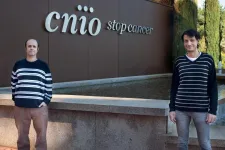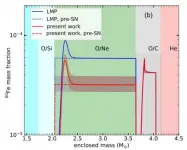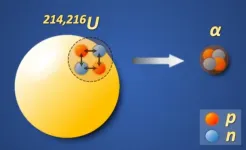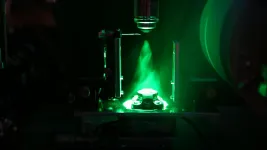(Press-News.org) Understanding the components that control cell division is fundamental to understanding how life works and how alterations in this delicate process can cause diseases such as cancer. It was precisely the discoveries of "key regulators of the cell cycle" and their implications for processes such as cancer, that won the British scientists R. Timothy Hunt and Paul M. Nurse and the American scientist Leland H. Hartwell the 2001 Nobel Prize in Physiology or Medicine. A study led by Óscar Fernández-Capetillo, Head of the Genomic Instability Group at the Spanish National Cancer Research Centre (CNIO) and published this week in The EMBO Journal uncovers a new cell cycle control element, the USP7 protein. It acts as a brake to prevent cells from dividing until the process of copying genetic material has been completed, and it also monitors this copying process to ensure that it happens correctly. "USP7 acts like a 'skipper' of the cells, who keeps the engines that drive cell division running at low speed," explains Fernández-Capetillo.
In addition to their importance for understanding the cell cycle, these results may have far-reaching implications for oncology as in the last three years several pharmaceutical companies around the world have been developing USP7 inhibitors for the treatment of this disease.
"Our study shows that USP7 inhibitors trigger an unbridled and premature activity of the machinery that controls the cell cycle, which, among other things, causes the genetic material to break apart as it tries to replicate," the researchers say.
"Understanding how these drugs work will help to improve the identification of patients who might benefit from their use, and also of potential combinations with other drugs that should be explored or avoided."
Cell death as a result of cell cycle over-activation
One of the most delicate and important processes that cells face in cell division is the copying of genetic material for subsequent distribution to daughter cells. If this happens in an abnormal way, cells can accumulate mutations that make them unstable and even cancerous.
In 2016, Fernández-Capetillo's team published a paper in the journal Nature Structural & Molecular Biology, in which they demonstrated that USP7 accompanies the cohort of molecules that form part of the replisome --a group of proteins involved in DNA copying-- to eliminate specific tags or signals called ubiquitins from the places in the genome where DNA is being copied, thus facilitating the replication process. Already at that time, the researchers suspected that, in addition to regulating DNA replication, USP7 inhibitors could also affect the cell cycle.
The pharmaceutical development of USP7 inhibitors as anticancer agents has been mainly based on their ability to activate the tumour suppressor protein P53, which is a potent inducer of cell suicide. However, in the 2016 paper mentioned above, Fernández-Capetillo's group already showed that the effects of these inhibitors on genome replication were not solely related to P53: "Our data indicate that USP7 is essential for genome replication in cells with or without p53," they said.
So, if not through P53, how can these inhibitors cause tumour cells to die? The paper published this week shows that the drugs have a direct effect on the cell cycle machinery that regulates cell division. Specifically, the researchers found that treatment with these inhibitors triggers premature and widespread activation of the CDK1 protein, a key driver of the cell cycle, which leads to uncontrolled cell division, DNA damage and ultimately cell death.
Potential combination therapies
The fact that USP7 inhibitors work by deregulating CDK1 opens the door to possible therapeutic combinations that could increase the efficacy of these drugs in cancer patients. According to the researchers in the article, there are several anticancer therapies in clinical trials that are acting at the same level, i.e. favouring the premature activation of CDK1, such as ATR or WEE1 inhibitors. "The effect of the combination of USP7 inhibitors together with other inhibitors that also promote CDK1 activity could be synergistic and increase the anticancer effects of these compounds in cancer patients," explains Fernández-Capetillo. "Furthermore, we also anticipate that drugs that decrease CDK1 activity will reduce the efficacy of USP7 inhibitors."
The findings of this new study also have other important implications for the use of these USP7 inhibitory compounds, as they confirm the 2016 observations that suggested these drugs can be effective regardless of whether tumours express P53 or not. The original idea that USP7 inhibitors work through stimulating P53 restricted their potential use to those patients whose tumours express this protein, which occurs in slightly less than 50% of cases. Therefore, the finding that these agents work by a P53-independent mechanism opens up their potential use to a much larger number of patients.
Currently, Fernández-Capetillo's group is focusing on uncovering new mechanisms of resistance to anticancer therapies, including USP7 inhibitors, to improve their efficacy in the clinic.
INFORMATION:
The study was funded by the Spanish Ministry of Science and Innovation, the Carlos III Institute of Health, the European Research Council and the European Regional Development Fund.
Reference article: USP7 limits CDK1 activity throughout the cell cycle. Antonio Galarreta, Pablo Valledor, Patricia Ubieto, Vanesa Lafarga, Marcos Malumbres, Emilio Lecona, Oscar Fernandez-Capetillo (The EMBO Journal, 2021). DOI: 10.15252/embj.201899692
Researchers from the Institute of Modern Physics (IMP) of the Chinese Academy of Sciences and their collaborators have recently made great progress in the study of the stellar beta-decay rate of 59Fe, which constitutes an important step towards understanding 60Fe nucleosynthesis in massive stars. The results were published in Physical Review Letters on April 12.
Radioactive nuclide 60Fe plays an essential role in nuclear astrophysical studies. It is synthesized in massive stars by successive neutron captures on a stable nucleus of 58Fe and, during the late stages of stellar evolution, ejected into space via a core-collapse supernova.
The characteristic gamma lines associated with the decay of 60Fe have been detected by space gamma-ray detectors. By comparing the 60Fe ...
The first photosynthetic oxygen-producing organisms on Earth were cyanobacteria. Their evolution dramatically changed the Earth allowing oxygen to accumulate into the atmosphere for the first time and further allowing the evolution of oxygen-utilizing organisms including eukaryotes. Eukaryotes include animals, but also algae, a broad group of photosynthetic oxygen-producing organisms that now dominate photosynthesis in the modern oceans. When, however, did algae begin to occupy marine ecosystems and compete with cyanobacteria as important phototrophic organisms?
In a new study Zhang et al use the molecular remains of ancient algae (so-called biomarkers) to show that algae occupied an important ...
It is always exciting to find new isotopes with extreme neutron/proton numbers in nuclear physics research. In the region of heavy nuclei, α-decay is one of the pervasive decay modes and plays an essential role in searching for new isotopes. However, even after about a century of studying α-decay, scientists still cannot perfectly describe how the α-particle is formed at the surface of the nucleus before its emission.
In the α-decay process, the α-particle can be regarded not only as two protons plus two neutrons, but also as two proton-neutron pairs. Although previous studies have proved the importance of the pairing forces between the identical nucleons, it remains unclear whether ...
Older adults are more willing to make an effort to help others than younger adults, according to new research from the University of Birmingham.
The study, led by researchers in the University's School of Psychology, is the first to show how effortful 'prosocial' behaviour - intended to benefit others - changes as people get older. In particular, it focused on people's willingness to exert physical effort, rather than to give money or time, since attitudes to both these are known to change with age. The research results are published in Psychological Science.
In the study, the research team tested a group of 95 adults aged between 18 and 36, and a group of 92 adults aged 55-85. Each participant made 150 choices about whether or not to grip a handheld ...
WASHINGTON, April 16, 2021 -- Early in the COVID-19 pandemic, doctors recognized that patients who developed a "cytokine storm" -- a surge of pro-inflammatory immune proteins -- were often the sickest and at highest risk of dying. But a cytokine storm can also occur in other illnesses, such as influenza. Today, scientists report preliminary results on a sweat sensor that acts as an early warning system for an impending cytokine storm, which could help doctors more effectively treat patients.
The researchers will present their results today at the spring meeting of the American Chemical Society (ACS). ACS Spring 2021 is being held online April 5-30. Live sessions will be hosted April 5-16, ...
Encoding information into light, and transmitting it through optical fibers lies at the core of optical communications. With an incredibly low loss of 0.2 dB/km, optical fibers made from silica have laid the foundations of today's global telecommunication networks and our information society.
Such ultralow optical loss is equally essential for integrated photonics, which enable the synthesis, processing and detection of optical signals using on-chip waveguides. Today, a number of innovative technologies are based on integrated photonics, including semiconductor ...
Researchers at Aalto University have developed a new device for spintronics. The results have been published in the journal Nature Communications, and mark a step towards the goal of using spintronics to make computer chips and devices for data processing and communication technology that are small and powerful.
Traditional electronics uses electrical charge to carry out computations that power most of our day-to-day technology. However, engineers are unable to make electronics do calculations faster, as moving charge creates heat, and we're at the ...
Vitamin D deficiency may impair muscle function due to a reduction in energy production in the muscles, according to a mouse study published in the Journal of Endocrinology. Vitamin D deficient mice were found to have impaired muscle mitochondrial function, which may have implications for muscle function, performance and recovery. This may suggest that preventing vitamin D deficiency in older adults could help maintain better muscle strength and function and reduce age related muscle deterioration, but further studies are needed to confirm this.
Vitamin D is a hormone well known to be important for maintaining bone health and preventing ...
Douglas Wilbur '14, a visiting Ph.D. scholar in the Department of Communication at UTSA, has published a study that shows how researchers can craft message campaigns to protect individuals from adopting extremist views.
According to his research, when people are explicitly told that they are free to accept or reject propagandistic claims, the likelihood of choosing a moderate view increases. This was a result of a survey of attitudes that tested counter-propaganda strategies, which stressed a person's autonomy, and then measured sentiments after exposure.
The study was ...
Sophia Antipolis - 16 April 2021: Working hours that deviate from an individual's natural body clock are associated with greater cardiovascular risk, according to research presented at ESC Preventive Cardiology 2021, an online scientific congress of the European Society of Cardiology (ESC).1
"Our study found that for each hour the work schedule was out of sync with an employee's body clock, the risk of heart disease got worse," said study author Dr. Sara Gamboa Madeira of the University of Lisbon, Portugal.
At least 20% of European employees work atypical hours or shifts,2 and growing scientific evidence associates these with deleterious cardiovascular outcomes.3 A number of explanations ...






